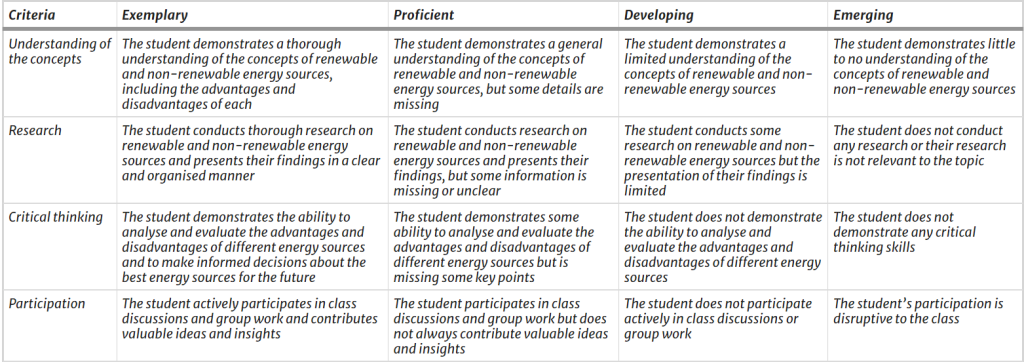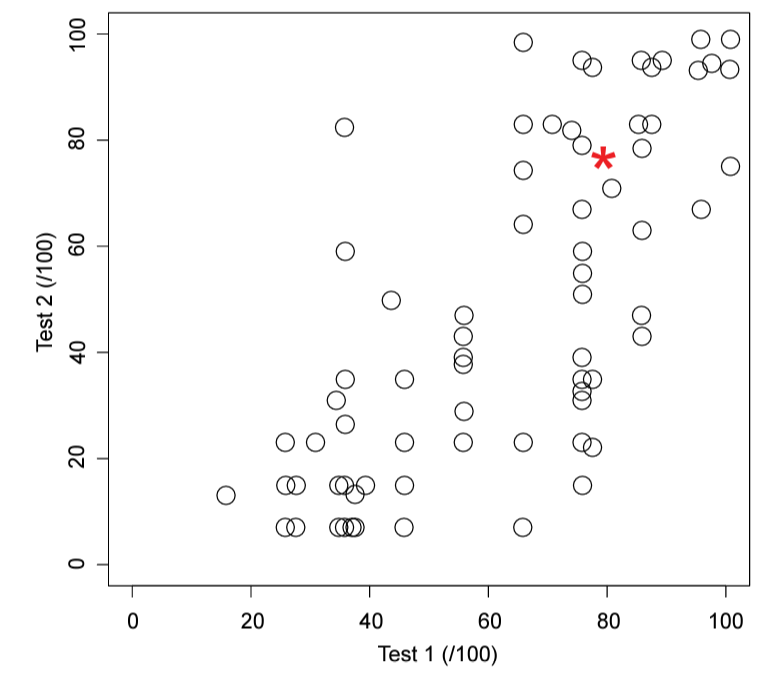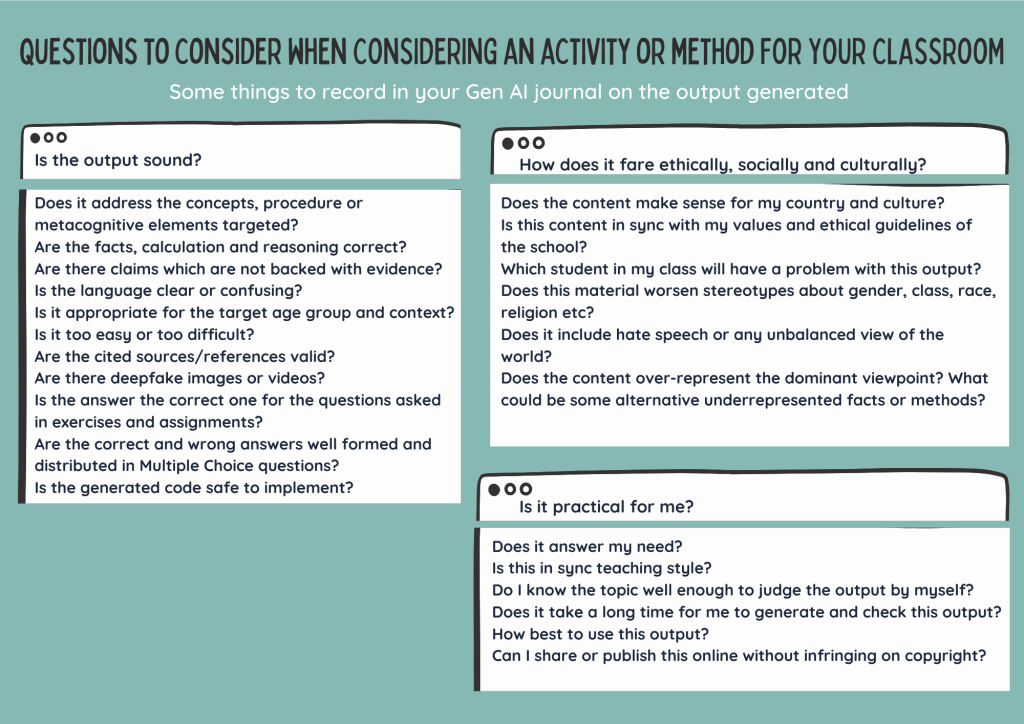On Generative AI
35 Generative AI for the Classroom, part 2
Some ideas for activities using generative AI
1. Use generative AI for course and lesson planning and design
Would you like new ideas on redesigning some of your courses, introducing new topics, activities to include and rubric on how to evaluate the results of these activities1,2? Would you like to try a new pedagogical approach, using new technology and materials3? Chatbots could potentially help with all of the above. You could direct the software to write out the first draft for lesson plans, learning objectives, directions for activities, projects and scientific experiments and discussion prompts4.
Tip: It is a good idea to specify beforehand what topics and approaches to cover and what the course or lesson would achieve – whether it is a concept or a procedure you are targeting and what kind of teaching you want to apply2.
Example
Source: Examining Science Education in ChatGPT: An Exploratory Study of Generative Artificial Intelligence5
Activity: Creating a teaching unit
Gen AI tool : ChatGPT
Prompt used: Create a teaching unit using the 5Es model that is challenging for students who have a strong understanding of renewable and non‐renewable energy sources at a year 7 level. Also provide support and scaffolding for students who are struggling with the material.
Reflection: As a starting point, the author found the ChatGPT response useful. It had to be adjusted in order to cater to students’ needs, the curriculum and to access resources. He suggests that educators should delete unhelpful parts and build on parts that are helpful. Though the output needs refining, he suspects many teachers will find it useful, especially those who are just starting their careers, as they may not have yet built extensive resources.
“I was particularly impressed by its capacity to generate a science unit underpinned by the 5Es model, even if some of the output seemed a little generic and in need of further refinement.“
2. Use generative AI for preparing engaging, multimodal and inclusive content on a topic
You could use a generative AI application to:
- Add content related to local phenomena, language and culture;
- Insert explanatory and attractive images and videos3;
- Create and include stories that reinforce textual content;
- Build concept maps;
- Highlight, paraphrase and summarise relevant portions of the lesson, and clarify vocabulary6;
- Make maths and science less abstract by showing simulations and including examples from other subjects. This could also be used in craft education where visualisation can help with developing and exploring ideas7;
- Provide translations to help learners who use minority languages2.
Tip: Midjourney and other image-creation tools often have dedicated forums where people post their work, advice, prompts and prompt-crafting hints7. They are helpful for teachers who are just starting to explore this technology.
3. Use Generative AI to create examples, practice exercises and quizzes
Generative AI can
- Generate tabular and other forms of data to use in examples and exercises;
- Create practice exercises and solutions, especially to reinforce foundational skills and low-knowledge components8. These can serve as a reference for students who are struggling to solve assignment problems9;
- Generate explanations for solutions. This seems to work well, especially for generating explanations of programming codes9;
- Generate multiple solutions for the same problem in maths or in programming. This helps students to learn different approaches and perspectives, and to analyse different methods, their advantages and disadvantages9. This could even help when the provided solutions are incorrect, when clearly marked so.
Example
Source: Examining Science Education in ChatGPT: An Exploratory Study of Generative Artificial Intelligence5.
Activity: Creating a quiz.
Gen AI tool: ChatGPT.
Prompt used: Generate a Quiz on the concept of renewable and non‐renewable energy sources at a year 7 level and include answer key.
Reflection: The author found that the ChatGPT-generated multiple-choice questions assessed students’ understanding of the topic. He said, “educators need to critically evaluate any resources… Teachers’ expertise, experience, and understanding of their students remain key to making sound pedagogical decisions.”
Example
Source: Examining Science Education in ChatGPT: An Exploratory Study of Generative Artificial Intelligence5.
Activity: Creating a rubric for grading.
Gen AI tool: ChatGPT.
Prompt used: Create a rubric that year 7 students can use to self‐assess their learning about renewable and non‐renewable energy sources (with the follow‐up formatting request: make this rubric easier to copy to Word in a tidy format).
Output:

Reflection: The author found that ChatGPT was able to create a rubric with its own criteria – understanding, research, critical thinking and participation. Levels were marked for each, but the indicators were too vague for each criterion.
Example
Source: The Robots Are Coming: Exploring the Implications of OpenAI Codex on Introductory Programming10.
Activity: Generating multiple solutions for a question.
Gen AI tool: Codex (Codex can generate code in several programming languages in response to prompts).
Prompt used: Problem description as found in various sources and exam questions on writing code, as given to students.
Output:

Reflection: The authors found that Codex gave a range of different codes to the same prompt, “while ultimately favouring expected methods for each response”.
4 Increasing accessibility
As a final example, we strongly urge you to explore generative AI to increase accessibility for students with certain physical or learning disabilities, especially those with hearing or visual impairments. Generative AI can provide subtitles, captions and audio descriptions2. As per Unesco’s Guidance for generative AI in education and research, “GenAI models can also convert text to speech and speech to text, to enable people with visual, hearing, or speech impairments to access content, ask questions, and communicate with their peers”2. It can also help you verify that the content you create is inclusive and accessible4.
Questioning the output
If you do decide to use generative AI, you have to watch out for its failures and shortcomings and be ready to correct them. These include
- Inaccuracies in the content: The language model is not a knowledge bank or a search engine. Even the latest models hallucinate facts and cite fictitious sources. Errors creep up, especially when using language models for mathematics and quantitative reasoning. Even when fine-tuned specifically for these subjects, the model can produce incorrect answers, calculation errors and hallucinate “mathematical facts”11. Even programming could be tricky, because generated code can have incorrect syntax and security issues9.
- Biases that creep up because, among other things, the data these models were trained on was riddled with them. Even EdGPT, which is corrected for this, might still contain a few of them2.
- Performance that can vary highly with the prompt used, user history, and, sometimes, with no reason at all.

While generative AI can reduce teacher workload and help with certain tasks, it is based on statistical models that have been constructed from huge amounts of online data. This data cannot replace the real world, its contexts and relationships. ChatGPT cannot provide context or explain what is affecting a student’s daily life4. It cannot provide new ideas or solutions to real-world challenges2.
Finally, its performance does not approach the capabilities of the human mind – especially what it can understand and do with limited data. Generative AI’s “deepest flaw is the absence of the most critical capacity of any intelligence: to say not only what is the case, what was the case and what will be the case – that’s description and prediction – but also what is not the case and what could and could not be the case12.”
1 Tlili, A., Shehata, B., Adarkwah, M.A. et al, What if the devil is my guardian angel: ChatGPT as a case study of using chatbots in education, Smart Learning Environments, 10, 15 2023.
2 Holmes, W., Miao, F., Guidance for generative AI in education and research, UNESCO, Paris, 2023.
3 Enkelejda, K., et al, Chatgpt for Good? on Opportunities and Challenges of Large Language Models for Education, EdArXiv, 2023.
4 Trust, T., Whalen, J., & Mouza, C., Editorial: ChatGPT: Challenges, opportunities, and implications for teacher education, Contemporary Issues in Technology and Teacher Education, 23(1), 2023.
5 Cooper, G., Examining Science Education in ChatGPT: An Exploratory Study of Generative Artificial Intelligence, Journal of Science Education and Technology, 32, 444–452, 2023.
6 Kohnke, L., Moorhouse, B. L., & Zou, D., ChatGPT for Language Teaching and Learning, RELC Journal, 54(2), 537-550, 2023.
7 Vartiainen, H., Tedre, M., Using artificial intelligence in craft education: crafting with text-to-image generative models, Digital Creativity, 34:1, 1-21, 2023.
8 Bhat,S., et al, Towards automated generation and evaluation of questions in educational domains, Proceedings of the 15th International Conference on Educational Data Mining, pages 701- 704, Durham, United Kingdom, 2022.
9 Becker, B., et al, Programming Is Hard – Or at Least It Used to Be: Educational Opportunities and Challenges of AI Code Generation, Proceedings of the 54th ACM Technical Symposium on Computer Science Education V. 1 (SIGCSE 2023), Association for Computing Machinery, New York, 500–506, 2023.
10 Finnie-Ansley, J., Denny, P. et al, The Robots Are Coming: Exploring the Implications of OpenAI Codex on Introductory Programming, Proceedings of the 24th Australasian Computing Education Conference (ACE ’22), Association for Computing Machinery, New York, 2022.
11 Lewkowycz, A., Andreassen, A., Dohan, D. et al, Solving Quantitative Reasoning Problems with Language Models, Google Research, 2022.
12 Chomsky, N., Roberts, I., Watumull, J., Noam Chomsky: The False Promise of ChatGPT, The New York Times, 2023.
